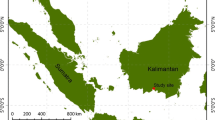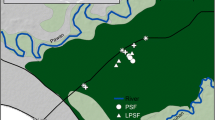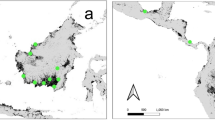Abstract
Restoration of deforested and drained tropical peat swamp forests is globally relevant in the context of reducing emissions from deforestation and forest degradation. The seasonal flux of carbon dioxide (CO2), methane (CH4), and nitrous oxide (N2O) in a restoration concession in Central Kalimantan, Indonesia, was measured in the two contrasting land covers: shrubs and secondary forests growing on peatlands. We found that land covers had high, but insignificantly different, soil carbon stocks of 949 + 56 and 1126 + 147 Mg ha−1, respectively. The mean annual CO2 flux from the soil of shrub areas was 52.4 ± 4.1 Mg ha−1 year−1, and from secondary peat swamp forests was 42.9 ± 3.6 Mg ha−1 year−1. The significant difference in mean soil temperature in the shrubs (31.2 °C) and secondary peat swamp forests (26.3 °C) was responsible for the difference in total CO2 fluxes of these sites. We also found the mean annual total soil respiration was almost equally partitioned between heterotrophic respiration (20.8 + 1.3 Mg ha−1 year−1) and autotrophic respiration (22.6 + 1.5 Mg ha−1 year−1). Lowered ground water level up to − 40 cm in both land covers caused the increase of CO2 fluxes to 40–75%. These numbers contribute to the provision of emission factors for rewetted organic soils required in the national reporting using the 2013 Supplement of the 2006 Intergovernmental Panel on Climate Change (IPCC) Guidelines for wetlands as part of the obligation under the United Nations Framework Convention on Climate Change (UNFCCC).








Similar content being viewed by others
References
Abrams JF, Hohn S, Rixen T, Baum A, Merico A (2016) The impact of Indonesian peatland degradation on downstream marine ecosystems and the global carbon cycle. Glob Chang Biol 22(1):325–337. https://doi.org/10.1111/gcb.13108
Baral KJ, Arthur E, Olesen JE, Petersen SO (2016) Predicting nitrous oxide emissions from manure properties and soil moisture: an incubation experiment. Soil Biol Biochem 97:112–120. https://doi.org/10.1016/j.soilbio.2016.03.005.
Bouwer H, Rice RC (1976) A slug test for determining hydraulic conductivity of unconfined aquifers with completely or partially penetrating wells. Water Resour Res 12(3):423–428. https://doi.org/10.1029/WR012i003p00423
Carlson KM, Goodman LK, May-Tobin CC (2015) Modeling relationships between water table depth and peat soil carbon loss in Southeast Asian plantations. Environ Res Lett 10(7):074006. https://doi.org/10.1088/1748-9326/10/7/074006.
Chimner RA (2004) Soil respiration rates of tropical peatlands in Micronesia and Hawaii. Wetlands 24(1):51–56. https://doi.org/10.1672/0277-5212(2004)024[0051:SRROTP]2.0.CO;2
Comeau L-P, Hergoualc’h K, Smith JU, Verchot L (2013) Conversion of intact peat swamp forest to oil palm plantation: effects on soil CO2 fluxes in Jambi, Sumatra. Center for International Forestry Research (CIFOR), Bogor
Dariah A, Marwanto S, Agus F (2014) Root- and peat-based CO2 emissions from oil palm plantations. Mitig Adapt Strateg Glob Chang 19(6):831–843. https://doi.org/10.1007/s11027-013-9515-6
Dommain R, Couwenberg J, Joosten H (2011) Development and carbon sequestration of tropical peat domes in south-east Asia: links to post-glacial sea-level changes and Holocene climate variability. Quat Sci Rev 30(7-8):999–1010. https://doi.org/10.1016/j.quascirev.2011.01.018.
Gumbricht T, Roman-Cuesta RM, Verchot L, Herold M, Wittmann F, Householder E, Herold N, Murdiyarso D (2017) An expert system model for mapping tropical wetlands and peatlands reveals South America as the largest contributor. Glob Chang Biol. 23(9):3581–3599. https://doi.org/10.1111/gcb.13689
Hiraishi T, Krug T, Tanabe K, Srivastava N, Baasansuren J, Fukuda M, Troxler TG (eds) (2014) 2013 supplement to the 2006 IPCC guidelines for National Greenhouse Gas Inventories: wetlands. IPCC, Switzerland
Hogan JM, van der Kamp G, Barbour SL, Schmidt R (2006) Field methods for measuring hydraulic properties of peat deposits. Hydrol Process 20(17):3635–3649. https://doi.org/10.1002/hyp.6379
IPCC (2014) 2013 Supplement to the 2006 IPCC Guidelenes for National Greenhouse Gas Inventories: Wetlands. In: Hirashi T, Krug T, Tanabe K, Srivastava N, Baasunsuren J, Fukuda M, and Troxler TG (eds) IPCC, Switzerland
Jauhiainen J, Hooijer A, Page SE (2012) Carbon dioxide emissions from an Acacia plantation on peatland in Sumatra, Indonesia. Biogeosciences 9(2):617–630. https://doi.org/10.5194/bg-9-617-2012
Kauffman JB, Arifanti VB, Basuki I, Kurnianto S, Novita N, Murdiyarso D, Donato DC, Warren MW (2016) Protocols for the measurement, monitoring, and reporting of structure, biomass, carbon stocks and greenhouse gas emissions in tropical peat swamp forests. Center for International Forestry Research (CIFOR), Bogor
Kim DJ, Chung SG, Lee SH, Choi JW (2012) Relation of microbial biomass to counting units for Pseudomonas aeruginosa. Afr J Microbiol Res 6(21):4620–4622. https://doi.org/10.5897/AJMR10.902.
Lähteenoja O, Ruokolainen K, Schulman L, Alvarez J (2009) Amazonian floodplains harbor minerotrophic and ombrotrophic peatlands. Catena 79(2):140–145. https://doi.org/10.1016/j.catena.2009.06.006
Lähteenoja O, Reategui YR, Rasanen M, Del Castillo Torres D, Oinonen M, Page S (2011) The large Amazonian peatland carbon sink in the subsiding Pastaza-Maranon foreland basin, Peru. Glob Chang Biol 18(1):164–178. https://doi.org/10.1111/j.1365-2486.2011.02504.x
Linn DM, Doran JW (1984) Effect of water-filled pore space on carbon dioxide and nitrous oxide production in tilled and nontilled soils. Soil Sci Soc Am J 48(6):1267–1272. https://doi.org/10.2136/sssaj1984.03615995004800060013x
Manuri S, Brack C, Nugroho NP, Hergoualc’h K, Novita N, Dotzauer H, Verchot L, Putra CAS, Widyasari E (2014) Tree biomass equations for tropical peat swamp forest ecosystems in Indonesia. For Ecol Manag 334:241–253. https://doi.org/10.1016/j.foreco.2014.08.031
Meurer KHE, Franko U, Stange CF, Rosa JD, Madari BE, Jungkunst HF (2016) Direct nitrous oxide (N2O) fluxes from soils under different land use in Brazil—a critical review. Environ Res Lett 11(2):023001. https://doi.org/10.1088/1748-9326/11/2/023001
Miettinen J, Shi C, Liew SC (2012) Two decades of destruction in Southeast Asia’s peat swamp forests. Front Ecol Environ 10(3):124–128. https://doi.org/10.1890/100236
Miettinen J, Hooijer A, Vernimmen R, Liew SC, Page SE (2017) From carbon sink to carbon source: extensive peat oxidation in insular Southeast Asia since 1990. Environ Res Lett 12:024014. https://doi.org/10.1088/1748-9326/115b6f
Murdiyarso D, Hergoualc’h K, Verchot LV (2010) Opportunities for reducing greenhouse gas emissions in tropical peatlands. PNAS 107(46):19655–19660. https://doi.org/10.1073/pnas.0911966107
Novita N (2016) Carbon stocks and soil greenhouse gas emissions associated with forest conversion to oil palm plantations in Tanjung Puting tropical peatlands, Indonesia. Dissertation, Oregon State University
Sayok AK, Nik AR, Melling L, Samad RA, Efransyah E (2008) Some characteristics of peat in Loagan Bunut National Park, Sarawak, Malaysia. Proceedings of the International Symposium, Workshop and Seminar on Tropical Peatland, Yogyakarta, pp 27–31. http://www.geog.le.ac.uk/carbopeat/yogyaproc.html. Accessed 25 Aug 2017
Skopp J, Jawson MD, Doran JW (1990) Steady-state aerobic microbial activity as a function of soil water content. Soil Sci Soc Am J 54(6):1619–1625. https://doi.org/10.2136/sssaj1990.03615995005400060018x.
Warren M, Hergoualc’h K, Kauffman JB, Murdiyarso D, Kolka R (2017) An appraisal of Indonesia’s immense peat carbon stock using national peatland maps: uncertainties and potential losses from conversion. Carbon Balance Manag 12(1):12. https://doi.org/10.1186/s13021-017-0080-2
Acknowledgements
We also acknowledge in-kind contributions of PT Rimba Makmur Utama, Jakarta, Indonesia, and their field staff.
Funding
This work is supported by the United States Agency for International Development (USAID) through the Sustainable Wetlands Adaptation and Mitigation Program (SWAMP) (Grant Agreement No. MTO 069018), to the Center for International Forestry Research (CIFOR).
Author information
Authors and Affiliations
Corresponding author
Electronic supplementary material
ESM 1
(DOCX 28 kb).
Rights and permissions
About this article
Cite this article
Murdiyarso, D., Saragi-Sasmito, M.F. & Rustini, A. Greenhouse gas emissions in restored secondary tropical peat swamp forests. Mitig Adapt Strateg Glob Change 24, 507–520 (2019). https://doi.org/10.1007/s11027-017-9776-6
Received:
Accepted:
Published:
Issue Date:
DOI: https://doi.org/10.1007/s11027-017-9776-6




